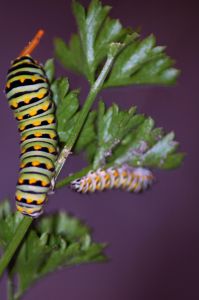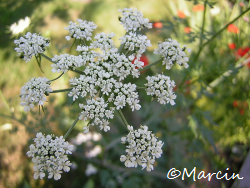Parsley Characteristics
(Carum Petroselinum, Linn.)

Name Origin:
Relates to the habitat of the parsley plant in nature, where it naturally grows among rocks – the Greek word of which is petros. To learn more about the origin of parsley, visit our History of Parsley page.
Natural Order:
Umbelliferæ
Growing Cycle:
Hardy biennial herb
Origins:
Native to Mediterranean shores, and cultivated for at least 2,000 years. As early as the 15th century there are records that parsley had developed several well-defined forms and numerous varieties. Parsley now has the largest number of varieties among all garden herbs.
Height:
Parsley grows to a height 2 feet or more tall when it flowers in the second season.
Characteristics:
Dark green leaves with long stalks.
Parsley Flowers:
Erect, branched flower stems which bear umbels of little white flowers.
How to Grow Parsley
(Seeds, planting, cultivation, harvesting seed, and harvesting fresh leaves.)
Of all of the sweet herbs, parsley is perhaps one of the easiest to grow. Parsley plants will thrive in ordinary soil with only a moderate amount of light; making it a great option for container gardens.
We found only one source that proclaims they are growing parsley from cuttings. They list several references but none of them discuss growing parsley from cuttings. From everything we’ve read, parsley can only be propagated from seed.
Growing Parsley From Seed.
Parsley seed is notoriously slow to germinate and can require 4-6 weeks to sprout. Soaking parsley seeds in warm water for at least 24 hours can help speed germination. We’ve had good success with placing parsley seeds in a wet, but not dripping, paper towel and putting the paper towel into a zip lock bag. We blow a bit of air into the bag before closing and put the bag with the parsley seeds on top of the refrigerator. The key to growing parsley from seed is patience.
Once the seeds sprout and the root seems strong, we gently remove them from the paper towel and plant the sprouted parsley seeds into a mixture of potting soil and growing medium. By combining the growing medium and potting soil we seem to gain the benefits of both – the soil doesn’t dry out so fast and the growing medium is more light and airy.
The high moisture requirement means that parsley seeds should be sown very early.
Planting Parsley Seeds.
To plant parsley seeds directly in your garden, several sources recommend planting in cold frames or beds for later transplantation. One option is to sew in rows only 3-4 inches apart with alternating rows of radishes. By the time the parsley seedlings appear, the radishes will have already been harvested. The radishes will also help mark the rows as well as loosen the soil and shape the parsley seedlings.
Another common companion for parsley is lettuce. Another early producer, lettuce will be harvested just as the parsley is taking hold providing the gardener with a much more efficient use of their garden space. That said, once the parsley is established, lettuce is not a good parsley companion plant.
When sowing parsley seeds in open ground, set drills 12-15 inches apart with at least one inch between seeds.
As we’ve already discussed, there are a number of great companion plants for parsley. Before adding this culinary herb to your garden, be sure to check out our parsley companion planting guide.
Parsley Cultivation.
Conduct your first thinning around May to space plants two inches apart. When they begin crowding, harvest each second plant.
Parsley does best when the soil is supplied with humus, preferably from decaying leguminous (beans, peas, clover, alfalfa and others) crops or from stable manure.
Strangely enough, to maximize yields, young parsley plants respond well to being transplanted as many as three times during the growing cycle. But, once established, their long tap root makes transplantation more difficult and can negatively impact your plant’s overall health.
Harvesting Parsley.
Harvest parsley leaves as needed to flavor your cooking or cut up to half the leaves just above soil level. Cutting parsley should also stimulate your plant’s growth.

Parsley leaves are a favorite place for black swallowtail butterflies to lay their eggs, look for striped caterpillars prior to cutting the leaves. If your parsley plant is lucky enough to be found by these beautiful caterpillars, you will be surprised how their nibbling of the plant will lead to the plant’s flourishing. As small as they are, they also provide a bit of great fertilizer in their excrement as well.
A few years ago, we had purchased a discounted, late-season parsley plant. A few days later we had one of these beautiful caterpillars doing a bit of harvesting. Parsley is one of their favorite foods and our little fellow quickly ate our small plant down to a nub. Whether through our care, we babied that parsley plant to keep it healthy for our new friend, his excrement or his pruning, that bedraggled plant grew into a bushy plant within a few weeks.
Harvesting Parsley.
It is common for gardeners to divide their parsley plants into three parts so as to have a succession of cuttings. Once the plants have been cut, it usually takes about three weeks for a new crop of leaves to grow and mature. Larger overall yields will be achieved if only fully matured leaves are cut and the under-developed leaves are left to continue growing.
To harvest parsley, simply cut sprigs from the plant. Harvest the older growth first which will encourage your parsley plant to produce more leaves. When growing successive crops in your garden and harvesting parsley, keep in mind that 2-year-old plants will have a slightly weaker flavor than their younger counterparts.
Harvesting Parsley Seed.

Parsley plants are biennial which means that they live for two years and at the end of the second growing season will flower and produce seeds. When growing parsley for seed production, remove every imperfect or weak plant so that only the healthiest plants can fertilize each other. Protect these plants over the winter and they should bloom the next growing season. Plants tend to irregularly ripen their seeds which makes some seeds ready 1-3 weeks before others. Keep the harvests separate as the early seed producers should be given priority in next year’s garden.
Cut parsley seed heads when the bulk of the seed is brown or dark in color. When gathering the seed, take care to avoid shaking the stems and scattering the fine seeds. Thresh lightly over tightly woven fabric or old sheeting and retain only the ripest seed or shake into a paper bag. The stalks can be spread thinly on sheets and set in the sun for two days to ripen additional seed.
Dry all seed lots for 10-14 days to make sure they are thoroughly dry, turning daily.
Parsley Plant Uses.
Parsley is perhaps one of the most commonly used herbs in the kitchen. From a culinary standpoint, parsley can be used as an ingredient or garnish for most any dish.
Parsley Root.
Parsley root, in the culinary world refers to a plant in the parsley family that is actually a vegetable. Our research indicates that the roots of the herb are edible but should not be eaten in quantity by pregnant women.
Parsley Greats100 delicious recipes with parsley…available on Amazon.com.
Leaves.
Whether fresh or dried, parsley leaves can add a touch of flavor and color to most any dish. Minced green leaves are often mixed with other vegetables just before being served. Parsley transforms plain, boiled potatoes to a new level particularly when young, red potatoes are used.
Parsley Seeds.
Parsley seeds should not be eaten because of their high concentration of apiol.
Shopping for Parsley Seeds
Are you looking for the best place to buy parsley seeds? Have you considered Amazon.com? Yes, that wonderful online retailer that has your favorite books, Kindle readers and just about everything else under the sun – sells parsley seeds too – even organic and heirloom ones. Why not try one of these varieties the next time you place an order with them?
 Dark Green Flat Italian Parsley – Certified Organic Heirloom Seeds |
 500 Parsley “Triple Curled” (Petroselinum crispum) Seeds By Seed Needs |
 Seed Saver’s Exchange Organic, open-pollinated Giant from Italy Parsley Seeds (250 seed packet) |
 Culinary Herb Garden Seeds (8 Easy-to-grow Kitchen Herbs) |
